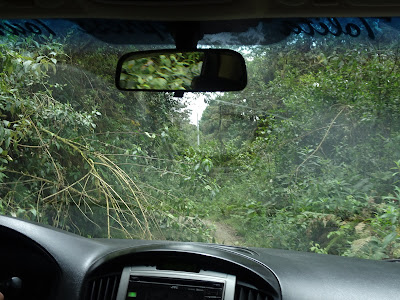Wednesday 9/15/21
(Teri) We didn’t have any water when we woke up this morning. No one seemed to be too worried. We were told it was probably a busted pipe. Our drinking and cooking water is a commercial bottled water, but washing water is from a nearby stream and is filtered before coming into the lodge. We were told to drink and brush our teeth only with the bottled water.
We had a light breakfast of eggs over easy on toast. Cereal is always available too, and Mark started having a bowl each morning as the meals had been light.
We weren’t going far this morning so we didn’t leave the lodge until 6:30 am.
We spent the morning in the
Upper Tandayapa Valley, a 30-minute
drive from the lodge.
The road hadn’t been cleared in a couple of years and we had to drive through some pretty overgrown areas.

In some areas the road was
wide and easy to walk on.
There were plenty of birds
and flowers to see this morning.
We came to an area that was being cleared and we had to back up and pull over a couple of times. We were told they clear the roads for the tourists.

We saw a lot of birds this morning and were back for lunch by noon. We had water when we arrived back.
Lunch started with a quinoa/potato
soup. We also had steak, potato, green
beans and rice. The plates were once
again splattered with this odd green sauce.
It didn’t have any taste and we never did figure out what it was.
We had the afternoon on our own and Mark wanted to take his camera with tripod and flash out on the back deck. The other guests had left and for our remaining time at the lodge we were the only group.
Everyone got back together at 6:00 pm to go over the bird list. Dinner was tomato soup with pasta, fried fish with 2 very thin slices of carrot and 2 very thin slices of squash, black quinoa and a wine soaked pear for dessert.
Wednesday, 9/15/2021 (Mark) – We birded the upper Tandayapa Valley by driving up above the lodge and then walking various sections of the road. It is at a higher elevation, and is nice and cool.
José spent a lot of time calling in an Ocellated Tapaculo, which is a notoriously tough bird to get eyes on. It is a skulker that calls frequently but stays buried in the undergrowth. We did get to see it, but this was the best I could do with the camera!
We also got our first (and turns out only) look at a Plushcap. For a long time the Plushcap was considered to be in its own family, but current thinking is that it may be related to Tanagers.
We always enjoy seeing large woodpeckers, and a male Powerful Woodpecker perched near the side of the road and gave us some nice looks.
Two target birds for this area were Crested Quetzal and Plate-billed Mountain-Toucan. We did get brief looks at each, but we would have liked to see them both more clearly. Maybe next time...
Flycatchers aren't as colorful or exotic as many of the other tropical birds, but there are dozens of different species and we enjoy trying to find, identify, and photograph them.
We returned to the lodge for lunch, and had an open afternoon which was welcome after several long days of birding. I finally got a chance to take the camera with flash out to the back deck and got a lot of great hummingbird pictures.
The flash is used at a very low power (1 - 2% of maximum output) and adds just enough "fill" light to lighten shadows and brighten the bird up a little. They don't even react to it.
Teri helped me to spot where the hummingbirds perched away from
the feeders, as I would always rather have a “natural” perch than a bird on
feeder. Remember when I said that most Ecuadorian hummingbirds don't have "Hummingbird" in their name? Check these out:
One of the largest hummingbirds in the area was the Sparkling Violetear. While not particularly aggressive, they would react to other hummingbirds. The final picture is a Sparkling Violetear flaring its "ears" and tail at an approaching hummingbird (the blur in the foreground).
Next time: Rio Silanche























Great pictures, especially the hummingbirds.
ReplyDeleteI didn’t know you can dial down the flash to such a degree.
This particular flash unit has a lot of manual adjustment available. The adjustment increments are in fractions, with the lowest power being 1/128. Another advantage of the very low power is that the flash can fire many times per second and keep up with the camera.
DeleteVery colorful pictures - the birds and the bright green splatters!
ReplyDeleteBright green splatter is really not that appetizing. We had some pink stuff show up later on. At least it had some taste.
Delete